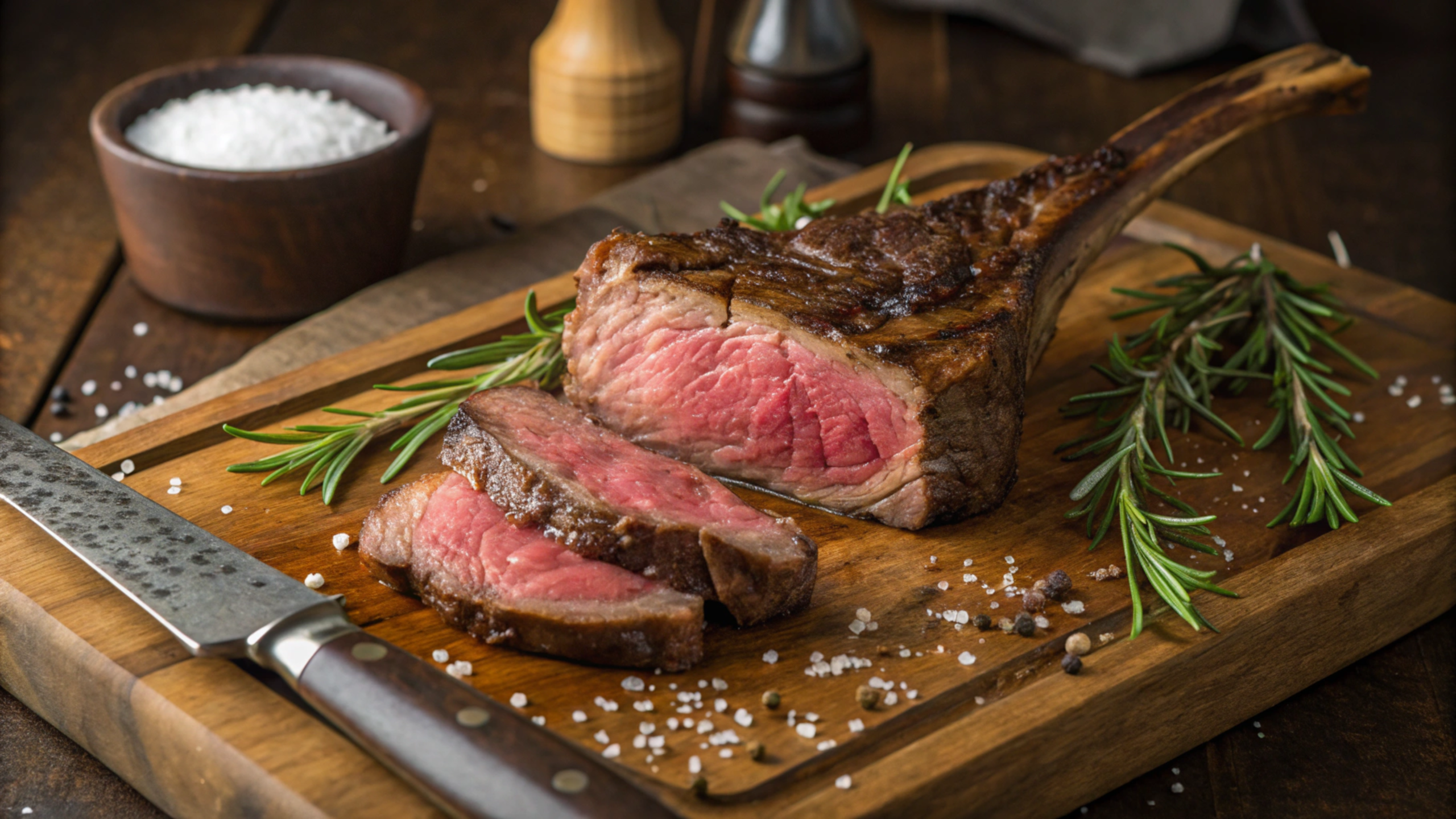Written by Sarah Miller
Tomahawk steak, a standout on any table, isn’t just a meal—it’s an experience. This guide covers everything you need to know about this special cut of beef. From its history to cooking tips, serving ideas, and even reheating tricks, you’ll learn how to get the most out of this amazing steak. Whether you’re an experienced cook or a steak lover looking to try something new, this article will give you the knowledge to perfect cooking a tomahawk steak. So, grab your knives, fire up the grill, and let’s get started!
What is a Tomahawk Steak?
What Defines a Tomahawk Steak?
A tomahawk steak is basically a ribeye steak with a long, Frenched bone left attached, resembling the handle of a tomahawk axe—hence the name. This cut comes from the rib section of the cow, specifically between the sixth and twelfth ribs, making it one of the tastiest and most tender cuts of beef. The long bone isn’t just for looks; it also adds richness to the meat by infusing marrow flavor during cooking.
Origins and History of the Tomahawk Cut
This cut started in early butchery, where large, bone-in steaks were prized for their bold appearance and rich taste. It became popular in fine dining for its impressive presentation. The tomahawk steak has strong ties to cooking traditions, combining rustic cooking with gourmet dining.
Tomahawk vs. Other Cuts: What Sets It Apart?
While ribeye steaks are recognized for their wealthy marbling, the tomahawk steak takes it to another degree with its dramatic bone. Compared to boneless cuts like New York strip or filet mignon, the tomahawk boasts a better fat content, making sure it is a juicy and flavorful chew whenever it is. The bone also acts as an insulator, producing a more flippantly cooked steak.
This introductory phase sets the stage for diving deeper into why this reduction is so unique and how to cook it to perfection in the next few parts. Stay tuned for more!
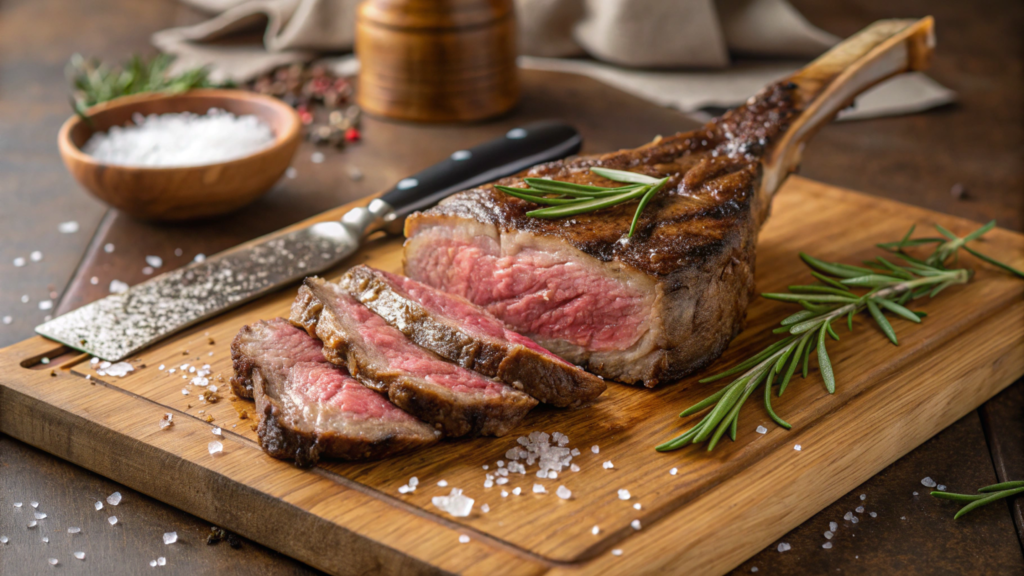
Why is the Tomahawk Steak So Special?
The Bone-In Advantage: Flavor and Presentation
The most noticeable feature of a tomahawk steak is its dramatic bone, which isn’t just for show. The long, Frenched bone adds to the steak’s visual appeal, making it a dish fit to be the star of any table. But its benefits go beyond looks. Cooking with the bone intact brings a deeper, richer flavor to the meat, thanks to the marrow and collagen released during cooking.
The bone also helps keep the steak evenly cooked. This is especially useful when grilling or reverse searing, as it prevents overcooking the outside while achieving a perfect medium-rare center.
The Gourmet Appeal: A Showstopper for Any Occasion
Few dishes can rival a tomahawk steak when it comes to impressing visitors or celebrating special moments. Its sheer length and unique appearance command interest. Often called the “king of steaks,” it’s ideal for events wherein presentation topics are as many as flavor. Whether served at a night meal or a family cookout, this steak elevates the eating experience.
Nutritional Profile
A tomahawk steak isn’t just indulgent—it’s filled with nutritional advantages. This cut presents a hefty protein dose, essential for muscle building and repair. Its marbled fat content also contributes to its soften-in-your-mouth texture and rich flavor. While it’s a nice treat enjoyed occasionally, its high tiers of iron, zinc, and B vitamins make it a nutritionally dense choice for steak fanatics.
How to Select the Perfect Tomahawk Steak
What to Look For on the Butcher or Grocery Store
Selecting a top-satisfactory tomahawk steak starts with knowing its characteristics. Look for steaks with enough marbling, as this ensures tenderness and flavor. The bone should be easy and white, a signal of proper coaching by the butcher. Opt for steaks that are at least 2 inches thick, as this thickness is good for achieving a perfect sear and juicy interior.
USDA Grades and Marbling: What They Mean
USDA grades—Prime, Choice, and Select—imply the first-rate of pork-based totally on marbling and age. For the fine tomahawk steak revel in, choose Prime grade, which has the best level of marbling. A properly-marbled Choice steak can also deliver high-quality outcomes if Prime isn’t to be had.
Local vs. Online: Where to Source the Best Steaks
Finding the right tomahawk steak may be as easy as visiting your neighborhood butcher, who often offers fresher and more customized cuts. Alternatively, premium onlineonline outlets like Snake River Farms or White Oak Pastures provide great steaks delivered to your doorstep. These alternatives frequently consist of pasture-raised or grass-fed pork, recognized for its advanced flavor and ethical sourcing practices.
For a delicious pairing with this steak, consider aspect dishes like this artisan Italian bread to finish your connoisseur meal.
Preparation Techniques
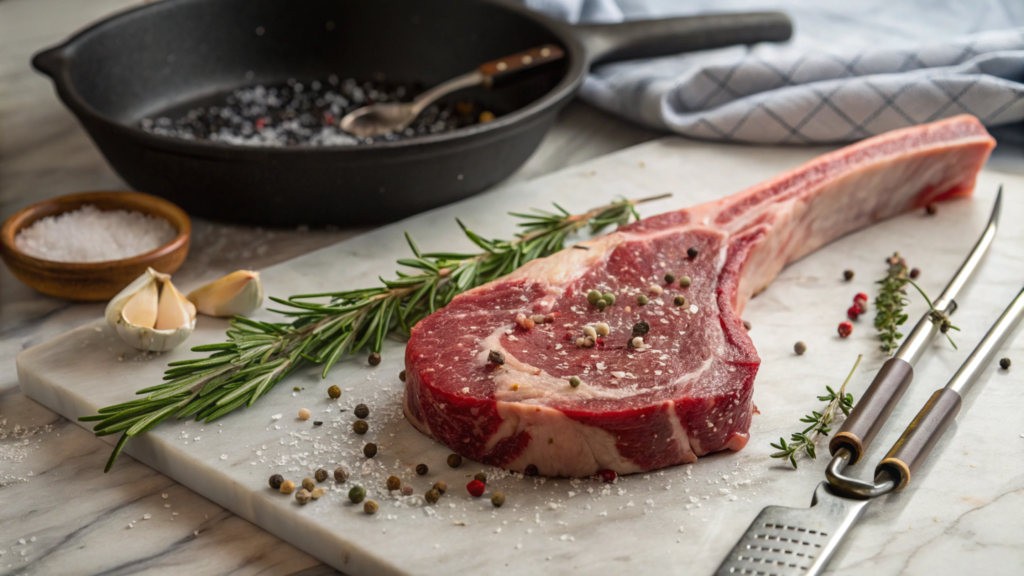
Room Temperature: Why It Matters
One of the secrets to cooking an excellent tomahawk steak is bringing it to room temperature before cooking. This easy step guarantees even cooking throughout the thick cut of meat. If the steak is too bloodless, the out-of-doors can also overcook while the internal stays undone. Allow the steak to sit out for approximately 30–60 minutes to mood.
Seasoning Tips: Keeping It Simple Yet Flavorful
When it comes to seasoning, less is more. A generous sprinkle of kosher salt, freshly cracked black pepper, and garlic powder is all you need to permit the tomahawk steak’s herbal flavors to shine. For an extra touch, rub the steak with olive oil or red meat tallow earlier than applying the seasonings. This helps create a stunning crust when it hits the grill.
Tools You Need for Cooking
To cook dinner a tomahawk steak like a pro, you will need the right equipment. A heavy solid iron skillet is best for searing. At the same time, a dependable meat thermometer ensures you hit the desired doneness without guesswork. If grilling, a two-quarter hearth setup is critical—direct heat for searing and indirect warmth for finishing.
For those looking for different hearty recipes, consider exploring this baked cottage cheese dish as a side dish for steak night.
Cooking Methods for Tomahawk Steak
Grilling to Perfection: Step-via-Step Guide
Grilling is one of the most famous ways to assemble a tomahawk steak. Start by preheating the grill to 400°F with a two-quarter setup. Place the steak over direct warmth for 4–five minutes according to facet to develop a crust. Then, pass it to the more superb area to prepare dinner until it reaches an internal temperature of one hundred thirty°F for medium-rare. Remember to let the steak relax for 10 minutes before slicing.
Reverse Searing: Achieving the Perfect Crust
Reverse searing is ideal for thicker cuts like a tomahawk steak. Begin by gradually roasting the steak in the oven at 250°F until it reaches an inner temperature of a hundred and ten°F. Then, finish it with a high-warmth sear in a cast iron skillet or on a grill to create a caramelized crust.
Using an Oven or Broiler: A Beginner-Friendly Method
If you don’t have a grill, you could still prepare a mouthwatering tomahawk steak using your oven or broiler. Preheat your oven to 500°F and sear the steak in a cast iron pan on the stovetop. Then, transfer the pan to the oven to cook the steak to your selected doneness. For added taste, baste it with butter, garlic, and sparkling herbs during the cooking technique.
Alternative Methods: Smoking or Campfire Cooking
For adventurous cooks, smoking a tomahawk steak adds a deep, smoky taste. Use a smoker set to 225°F and prepare dinner with the steak low and slow until it reaches the desired doneness. Alternatively, cooking the steak without delay over warm coals in a campfire gives a country an unforgettable revel.
Each technique offers a completely unique way to revel in the wealthy, buttery taste of a tomahawk steak. Choose the one that fits your fashion and device, and you’ll have a steak that’s bound to electrify.
For more mouthwatering recipes, explore our manual to southwest fowl salad. It’s a lighter choice to pair with your hearty tomahawk!
Serving and Pairing Ideas
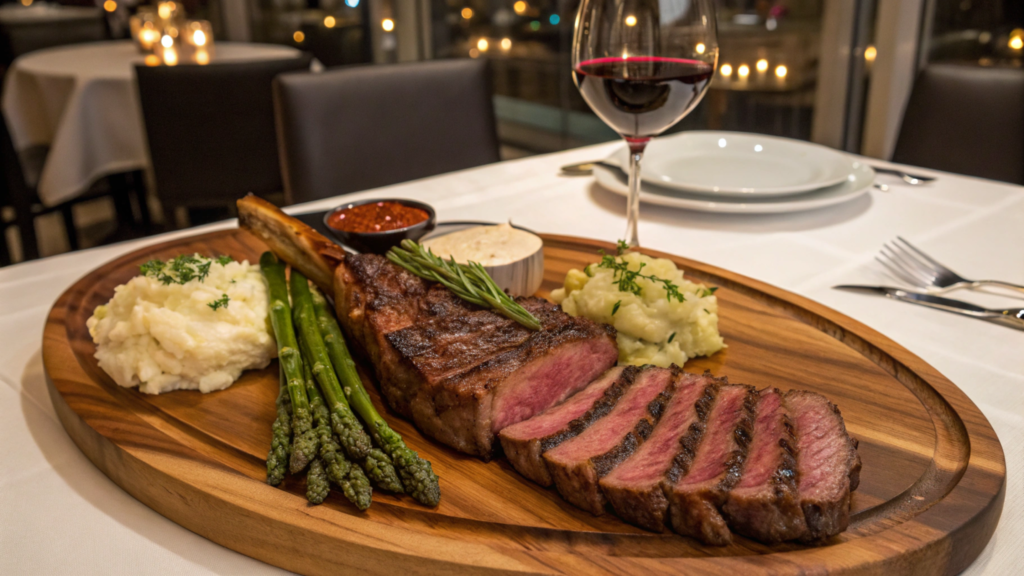
Resting the Steak: A Crucial Step for Juicy Results
After cooking your tomahawk steak, allowing it to rest for 10–15 minutes is critical. This step permits the juices to redistribute, ensuring each bite is soft and flavorful. Skipping this technique can lead to a drier steak, as the juices are more likely to spill out while sliced too soon. Place the steak on a cutting board, tent it loosely with foil, and allow it to rest earlier than serving.
Slicing and Presentation Tips
To serve your tomahawk steak like a seasoned one, slice it towards the grain. This technique shortens the muscle fibers, resulting in an extra-soft chunk. Using a pointy knife, carve the beef into thick, even slices and set them across the bone for a dramatic presentation. Don’t forget to sprinkle a hint of flaky sea salt on the pinnacle to decorate the taste.
Classic Side Dishes to Complement the Tomahawk Steak
Pairing the correct elements with your tomahawk steak elevates the entire meal. Classic picks like creamy mashed potatoes, roasted asparagus, or buttery corn on the cob stabilize the steak’s rich taste. Do not forget a crisp wedge salad or a tangy vinaigrette-tossed spinach salad for a clean evaluation.
Suppose you’re looking for unique facet dish ideas. In that case, our guide to spinach with boiled eggs gives a satisfying twist on conventional vegetables.
FAQs About Tomahawk Steak
What Cut of Steak is a Tomahawk?
A tomahawk steak is a ribeye steak with the rib bone left intact and Frenched for a putting look. The bone complements the steak’s flavor and presentation, making it a fave among enthusiasts.
Why is Tomahawk Steak So Expensive?
The excessive fee of a tomahawk steak stems from its top-class, first-class, and impressive presentation. The ribeye reduction is one of the most flavorful parts of the cow. At the same time, the additional effort to French the bone contributes to the cost.
Is a Tomahawk Better than a Ribeye?
While each cut comes from the same part of the cow, the tomahawk steak offers an entirely unique eating experience thanks to its lengthy bone and dramatic look. It’s ideal for unique activities or when presentation is fundamental. However, a boneless ribeye offers the identical flavor in an even smaller package.
What is So Special About a Tomahawk Steak?
What sets the tomahawk steak aside is its mixture of smooth meat, rich marbling, and ambitious presentation. The bone no longer only provides taste but also makes it a centerpiece-worthy dish that impresses at any amassing.
This phase addresses the most common questions about tomahawk steak, making it less difficult for readers to decide if this connoisseur’s cut is appropriate for them.
Common Mistakes to Avoid When Cooking Tomahawk Steak
Overcooking or Undercooking
One of the most significant pitfalls whilst preparing a tomahawk steak is not getting the doneness proper. Because the steak is so thick, it’s clear to overcook the outside while leaving the interior undercooked. Using a meat thermometer is vital to ensure precision. Aim for an internal temperature of one hundred thirty°F for medium-uncommon, which is the correct doneness for this reduction.
Not Letting the Steak Rest
Skipping the resting step is another commonplace mistake that can wreck a wonderfully cooked tomahawk steak. Resting permits the juices to redistribute throughout the beef, keeping it tender and juicy. Cutting into the steak too quickly causes the flavorful juices to spill out, leaving the meat dry and less pleasing.
Using the Wrong Tools or Techniques
The incorrect cooking equipment could ruin or damage your tomahawk steak experience. Avoid using lightweight pans or grills that don’t retain warmth properly. Instead, opt for heavy-duty solid iron or an extremely good grill to obtain that perfect crust. Additionally, avoid overcrowding the cooking region, as this could prevent the steak from searing flippantly.
Leftovers and Reheating Tips
Storing Tomahawk Steak Safely
Proper storage is key if you’re fortunate enough to have leftovers from your tomahawk steak. Place the steak in an airtight field or wrap it tightly in aluminum foil. Store it in the fridge for up to three days. For more extended storage, freeze the steak in a freezer-secure bag to keep it sparkling for up to a few months.
Reheating Methods for Maintaining Juiciness
Reheating a tomahawk steak without drying it out requires a gentle method. The oven is a dependable choice—set it to 275°F and place the steak on a baking sheet. Cover it with foil to lock in moisture and heat it until warmed through. For a quick repair, use a skillet with a touch of butter to reheat the steak on low heat, flipping it once in a while.
Creative Uses for Leftover Tomahawk Steak
Transform leftover tomahawk steak into something new and exciting. Slice it thinly for hearty steak sandwiches, or chop it up to make a flavorful steak salad. Add it to scrambled eggs for a protein-packed breakfast that’s tough to beat.
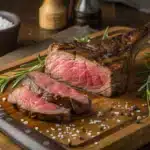
Tomahawk Steak
Ingredients
For the Steak
- 1 piece Tomahawk steak (2 inches thick) Look for well-marbled steak with a long Frenched bone
For Seasoning
- 2 tablespoons Kosher salt For seasoning the steak
- 1 teaspoon Freshly cracked black pepper For seasoning the steak
- 1 teaspoon Garlic powder For seasoning the steak
- 1 tablespoon Olive oil or beef tallow For rubbing on the steak before seasoning
Instructions
Preparation
- Remove the tomahawk steak from the refrigerator and let it rest at room temperature for 30-60 minutes.
- Season the steak generously on both sides with kosher salt, black pepper, and garlic powder. Rub with olive oil or beef tallow.
Cooking
- Preheat the grill to 400°F with a two-zone setup for direct and indirect heat.
- Sear the steak over direct heat for 4-5 minutes per side to develop a crust.
- Move the steak to the indirect heat side and cook until it reaches an internal temperature of 130°F for medium-rare.
- Let the steak rest for 10-15 minutes on a cutting board, tented with foil.
Serving
- Slice the steak against the grain into thick slices for serving.
- Serve with classic side dishes like creamy mashed potatoes or roasted asparagus.
